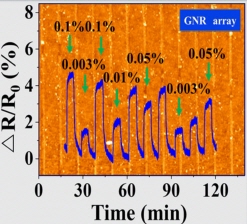Research
Hydrogen gas (H2) is considered to be a promising future energy source because of its abundance and environmental benignity. However, the use of H2 is inevitably accompanied by safety issues due to the high risk of explosions at H2 concentrations of greater than 4% in air. Therefore, portable hydrogen gas sensors enabling in-situ monitoring and compatibility to integrated circuits would be ubiquitous in the upcoming hydrogen economy era, especially in the field of fuel-cells, hydrogen vehicles, and hydrogen storage. For this reason, studied of H2 sensing materials have drawn considerable attention for years.
In our labs, a lithographically aligned palladium nanoribbon (Pd-NRB) array with gaps of less than 40 nm is fabricated on a PET substrate using the direct metal transfer method. The 200?μm Pd-NRB hydrogen gas sensor after bending treatment exhibits an unprecedented sensitivity of 109 % along with fast sensing behavior (80 % reponse time of 3.6 sec and 80 % recovery time of 8.7 sec) at room temperature.
References
"Palladium Nanoribbon Array for Fast Hydrogen Gas Sensing with Ultrahigh Sensitivity" Yusin Pak, Namsoo Lim, Yogeenth Kumaresan, Ryeri Lee, Kihyeun Kim, Tae Heon Kim, Sang-Mook Kim, Jintae Kim, Heon Lee, Moon-Ho Ham, Gun-Young Jung. Adv. Mater., 27, 6945-6952 (2015)

Polymer residue-free graphene nanoribbons (GNRs) of 200 nm width at 1 μm pitch were periodically generated in an area of 1 cm2 via laser interference lithography using a chromium interlayer prior to photoresist coating. High-quality GNRs were evidenced by atomic force microscopy, micro-Raman spectroscopy, and X-ray photoelectron spectroscopy measurements.
Palladium nanoparticles were then deposited on the GNRs as catalysts for sensing hydrogen gases, and the GNR array was utilized as an electrically conductive path with less electrical noise. The palladium-decorated GNR array exhibited a rectangular sensing curve with unprecedented rapid response and recovery properties: 90 % response within 60 s at 1000ppm and 80 % recovery within 90 s in nitrogen ambient. In addition, reliable and repeatable sensing behaviors were revealed when the array was exposed to various gas concentrations even at 30 ppm.
References
"Palladium-Decorated Hydrogen-Gas Sensors Using Periodically Aligned Graphene Nanoribbons" Yusin Pak, Sang-Mook Kim, Huisu Jeong, Chang Goo Kang, Jung Su Park, Hui Song, Ryeri Lee, NoSoung Myoung, Byoung Hun Lee, Sunae Seo, Jin Tae Kim, and Gun-Young Jung. ACS Appl. Mater. Interfaces ,?6 (15), pp 13293-13298 (2014)

Breath analysis is a promising field with great potential for non-invasive diagnosis of a number of disease states. Analysis of the concentrations of volatile organic compounds (VOCs) in breath can medicate a specific clinical status; lung and breast cancer, diabetes, etc.